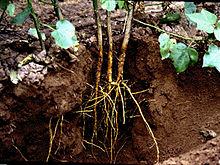This article needs additional citations for verification. (April 2017) |

Root pressure is the transverse osmotic pressure within the cells of a root system that causes sap to rise through a plant stem to the leaves.[1]
Root pressure occurs in the xylem of some vascular plants when the soil moisture level is high either at night or when transpiration is low during the daytime. When transpiration is high, xylem sap is usually under tension, rather than under pressure, due to transpirational pull. At night in some plants, root pressure causes guttation or exudation of drops of xylem sap from the tips or edges of leaves. Root pressure is studied by removing the shoot of a plant near the soil level. Xylem sap will exude from the cut stem for hours or days due to root pressure. If a pressure gauge is attached to the cut stem, the root pressure can be measured.
Root pressure is caused by active distribution of mineral nutrient ions into the root xylem. Without transpiration to carry the ions up the stem, they accumulate in the root xylem and lower the water potential. Water then diffuses from the soil into the root xylem due to osmosis. Root pressure is caused by this accumulation of water in the xylem pushing on the rigid cells. Root pressure provides a force, which pushes water up the stem, but it is not enough to account for the movement of water to leaves at the top of the tallest trees. The maximum root pressure measured in some plants can raise water only to 6.87 meters, and the tallest trees are over 100 meters tall.
- ^ F. Baluska; Milada Ciamporová; Otília Gasparíková; Peter W. Barlow, eds. (2013). Structure and Function of Roots: Proceedings of the Fourth International Symposium on Structure and Function of Roots, June 20–26, 1993. Vol. 58 (illustrated ed.). Springer Science & Business Media. p. 195. ISBN 9789401731010.